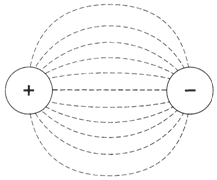Volt or Potential difference.
An accumulation of static electric charge, such as shortage or excess of electrons, is always, associated with the voltage. There are other situations also in which voltages exist. Voltage is mainly generated at a power plant, and produced by electrochemical reaction, and caused by light falling on a special semiconductor chip. It can be formed when an object is moved in a magnetic field, or is placed in the fluctuating magnetic field.
A potential difference between 2 points produces an electric field, represented by electric lines of flux. There is always a pole which is relatively positive, with fewer electrons, and 1 which is relatively negative, with more electrons. The positive pole does not have a deficiency of electrons compared with the neutral objects, and the negative pole might not have a surplus of electrons with the respect to neutral things. But there is always a difference in charge between the 2 poles. The negative pole has more electrons than the positive pole.
The abbreviation for volt is V. Sometimes, smaller units are used. The millivolt (mV) is equal to a thousandth (0.001) of a volt. The microvolt (µV) is equal to a millionth (0.000001) of a volt. And it is necessary to use units much larger than 1 volt. One kilovolt (kV) is equal to 1 thousand volts (1,000). One megavolt (MV) is equal to 1 million volts (1,000,000) or 1 thousand kilovolts.
In a dry cell, the EMF is between 1.2 and 1.7 V usually; in a car battery, it is most

Figure: Electric lines of flux always exist near poles of electric charge.
often 12 V to 14 V. In household utility wiring, it is a low-frequency alternating current of about 117 V for electric lights and most appliances, and 234 V for a washing machine, dryer, oven, or stove. In TV, transformers convert 117 V to around 450 V for the operation of the picture tube. In some of the broadcast transmitters, kilovolts are used. The largest voltages on Earth occur in between clouds, or in between clouds and the ground, in thundershowers; this potential difference is on order of tens of megavolts.
In every case, voltage, EMF, or potential difference represents the fact that charge carriers will flow between 2 points if a conductive path is provided. The number of charge carriers can be small even if the voltage is huge, or very large even if the voltage is tiny. Voltage signifies the pressure or driving force that impels the charge carriers to move. Generally for a given number of charge carriers, higher voltages will produce a faster flow, and therefore a larger current. It's like water pressure. The amount of water which will flow through a hose is proportional to water pressure, all other things being equal.